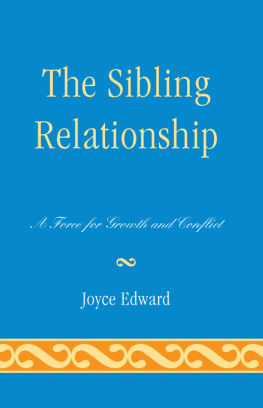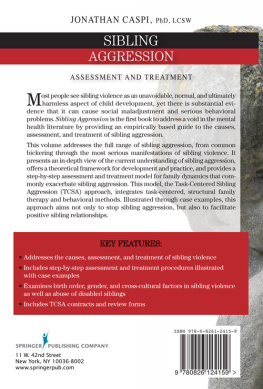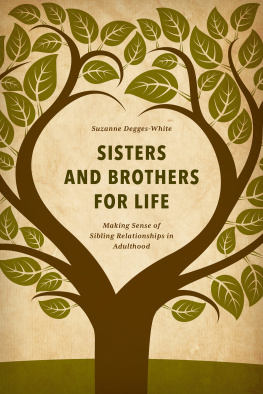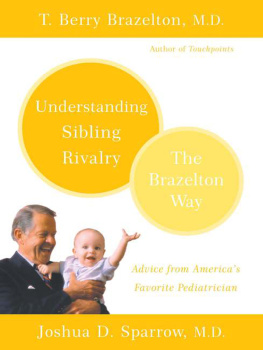The Sibling Relationship
The Sibling Relationship
A Force for Growth
and Conflict
Joyce Edward, LCSW, BCD

JASON ARONSON
Lanham Boulder New York Toronto Plymouth, UK
Published by Jason Aronson
An imprint of Rowman & Littlefield Publishers, Inc.
A wholly owned subsidiary of The Rowman & Littlefield Publishing Group, Inc.
4501 Forbes Boulevard, Suite 200, Lanham, Maryland 20706
http://www.rowmanlittlefield.com
Estover Road, Plymouth PL6 7PY, United Kingdom
Copyright 2011 by Jason Aronson
All rights reserved. No part of this book may be reproduced in any form or by any electronic or mechanical means, including information storage and retrieval systems, without written permission from the publisher, except by a reviewer who may quote passages in a review.
British Library Cataloguing in Publication Information Available
Library of Congress Cataloging-in-Publication Data
Edward, Joyce.
The sibling relationship : a force for growth and conflict / Joyce Edward.
p. cm.
Includes bibliographical references and index.
ISBN 978-0-7657-0732-1 (cloth : alk. paper) ISBN 978-0-7657-0734-5 (electronic)
1. Brothers and sistersPsychological aspects. I. Title.
BF723.S43E39 2011
155.9'24dc22 2010043840
 The paper used in this publication meets the minimum requirements of American
The paper used in this publication meets the minimum requirements of American
National Standard for Information SciencesPermanence of Paper for Printed Library
Materials, ANSI/NISO Z39.48-1992.
Printed in the United States of America
Acknowledgments
I am deeply indebted to all of those who have encouraged, supported, and facilitated the writing of this book. To Patsy Turrini, Bea Weinstein, Cecily Weintraub, and Diana Siskind, friends and colleagues, my warmest thanks for reviewing each chapter and giving me the benefit of their theoretical and clinical knowledge. Thanks as well to Barbara Coley, Sheila Felberbaum, Rene Goldman, Jeanine Klein, Laurie Rosen, and Naomi Schlesinger, who reviewed particular chapters and offered me their expertise. I should also like to acknowledge my teachers Gertrude and Rubin Blanck and Jacob Arlow whose contributions to psychoanalysis have informed and inspired my efforts.
This book could not been written without what I have learned from my patients, nor without the help of those many non-patients who shared their own or their patients sibling experiences with me. To the members of the American Association for Psychoanalysis, the Clinicians Exchange, the New York State Society for Clinical Social Work Clinical Society, and the New York School for Psychoanalytic Psychotherapy and Psychoanalysis, my thanks for the invaluable contributions they made to this effort.
To Julie Kirsch, the editorial director of Jason Aronson, who agreed to publish the book, my warmest thanks for her patience, her understanding, her help, and her support through this long undertaking. I could not have completed the book without the skill, wisdom, kindness, and good humor of Judy Cohen, who edited the book. Thanks also go to Dr. Camille Wortman for her assistance and to my dear granddaughter, Dana Sanders, who helped prepare the book for press.
Finally, I wish to warmly thank my sister, Rosemary Schiff, who has taught me so much about what it is to be a sister and what it is to have a sister, as well as my children and grandchildren, who have afforded me the opportunity to observe siblings in action these many years.
Introduction
E ver since Cain killed his brother Abel, the sibling relationship has been associated with envy, jealousy, hatred, and fratricide. So numerous are the accounts of sibling enmity in Genesis that Stephen Mitchell (1996), a modern translator of biblical stories, has suggested that conflict between siblings may be regarded as the theme of that biblical text. Although the Bible also introduces the idea of siblings as one anothers keeper, it is the animosity between those ancient brothers that has stood out over time, and with which modern day individuals seem to more strongly identify.
Indeed, Freud (19151916) was convinced that the hostility those biblical brothers felt for each other continues to be the earliest and most persistent attitude between siblings in modern times. A small child, Freud wrote, does not necessarily love his brothers and sisters: often he obviously does not. There is no doubt that he hates them as his competitors, and it is a familiar fact that this attitude often persists for long years, till maturity is reached or even later, without interruption. Quite oft, it is true, it is succeeded, or let us rather say overlaid, by a more affectionate attitude; but the hostile one seems very generally to be the earliest (p. 204). Freud tended to regard whatever affectionate feelings siblings develop toward one another, either as a defense against their basic hostility or an expression of aim-inhibited manifestations of early, erotic, incestuous wishes.
In his role as clinician Freud was often confronted with the outcome of troubled sibling relationships, which may have led him to overly focus on the negative aspects of the sibling bond. However, his own experiences with his brothers and sisters are also thought to have influenced his ideas. Freud was the oldest of eight children born to his mother. He had two half brothers that were some twenty years older than he, as well as a nephew, John, the son of one of his stepbrothers, who was a year older than Freud. In his autobiographical study, Freud (1925) made no mention of his siblings, which has led to some speculation that he bore them little affection (Coles 2003). However, he acknowledged elsewhere the impact that his next younger brother, Julius, had on him as well as the importance to him of his nephew, John, to whom he related as a brother.
Julius was born when Freud was one and a half. He died at six months of age, when Freud was just under two. In his self-analysis Freud discovered his rivalry with Julius and his strong murderous wishes toward him. In a letter he wrote to Wilhelm Fliess (Freud 18871904) Freud acknowledged the guilt he experienced over his jealousy and ill wishes.
According to Freud (1900b) he and his nephew John had been inseparable friends as children. They had both loved and hated each other. Freud recognized that their relationship had a significant influence on all of his subsequent relationships with his peers. He wrote,
All my friends, have in a certain sense been re-incarnations of this first figure.
... My emotional life has always insisted that I should have an intimate friend and a hated enemy. I have always been able to provide myself afresh with both, and it has not infrequently happened that the ideal situation of childhood has been so completely reproduced that friend and enemy have come together in a single individualthough not, of course, both at once or with constant oscillations, as may have been the case in my early childhood. (p. 483)
Although Freud recognized certain ways in which siblings could contribute positively to each others development, as will be seen later in this book, he, and for many years those psychoanalysts who followed him as well as members of allied professions, remained largely preoccupied with the difficulties siblings encounter in their relationships with each other (Neubauer 1983).
Some early psychoanalysts conducted extensive research on sibling rivalry (Levy 1937) and a number recorded their observations of their own offspring, which showed the intense negative reactions of their older child upon the birth of a new brother or sister (Neubauer 1982). Through educational means, several members of the psychoanalytic community tried to lessen the negative impact of the arrival of a new sibling (Buxbaum 1949, Hawkins 1946).











 The paper used in this publication meets the minimum requirements of American
The paper used in this publication meets the minimum requirements of American